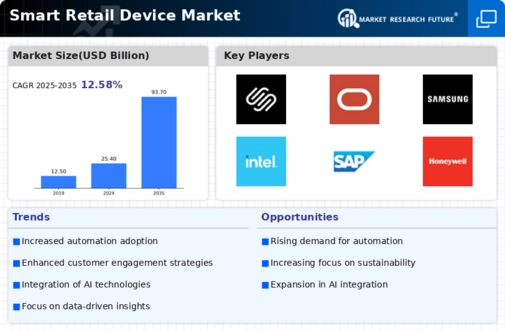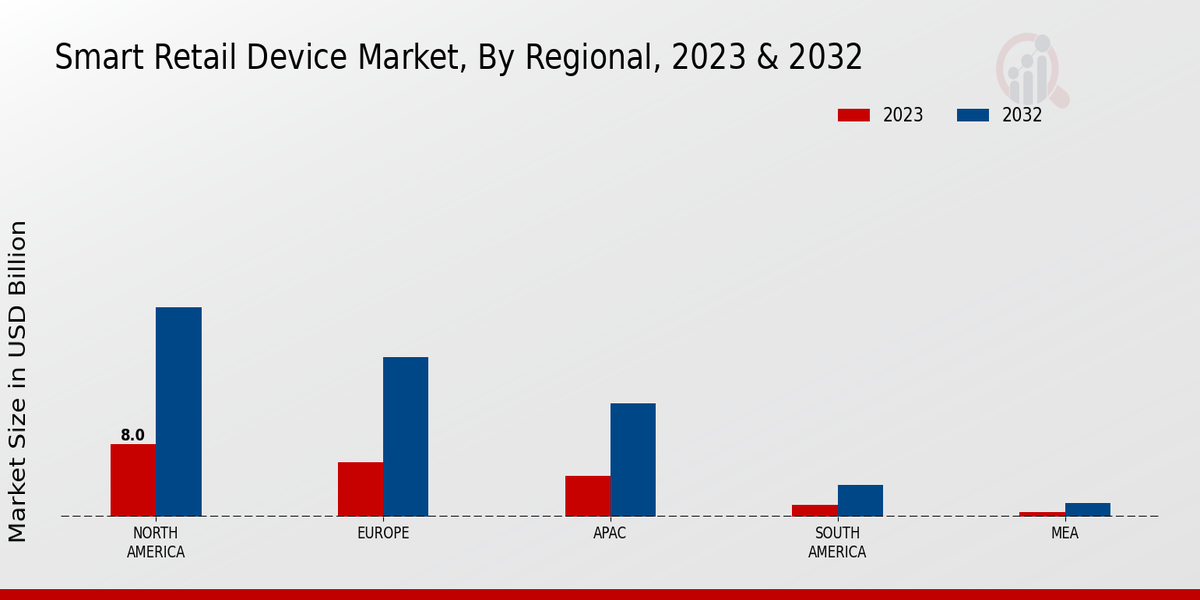Market Growth Projections
The Global Smart Retail Device Market Industry is poised for substantial growth, with projections indicating a rise from 25.4 USD Billion in 2024 to 93.7 USD Billion by 2035. This growth trajectory reflects a compound annual growth rate of 12.58% from 2025 to 2035. Such figures suggest a robust demand for smart retail technologies, driven by various factors including technological advancements and changing consumer preferences. The market's expansion may lead to increased competition among retailers, prompting further innovations in smart devices. As the industry evolves, stakeholders may need to adapt to these dynamics to capitalize on emerging opportunities.
Technological Advancements
The Global Smart Retail Device Market Industry experiences a robust growth trajectory, primarily driven by rapid technological advancements. Innovations in artificial intelligence, machine learning, and the Internet of Things are transforming retail operations. For instance, smart shelves equipped with sensors can monitor inventory levels in real-time, reducing stockouts and enhancing customer satisfaction. As of 2024, the market is valued at 25.4 USD Billion, indicating a strong demand for these technologies. Retailers are increasingly adopting smart devices to streamline operations and improve customer experiences, suggesting a shift towards more automated and efficient retail environments.
Consumer Demand for Personalization
In the Global Smart Retail Device Market Industry, there is a notable shift towards personalized shopping experiences. Consumers increasingly expect tailored recommendations and services, prompting retailers to invest in smart devices that analyze customer data. For example, smart kiosks can provide personalized promotions based on previous purchases, enhancing customer engagement. This trend is likely to contribute to the market's growth, with projections indicating a rise to 93.7 USD Billion by 2035. Retailers that leverage smart technologies to meet consumer preferences may gain a competitive edge, suggesting that personalization is a key driver in the evolving retail landscape.
Cost Efficiency and Operational Optimization
Cost efficiency remains a critical driver in the Global Smart Retail Device Market Industry. Retailers are increasingly adopting smart devices to optimize operations and reduce overhead costs. For example, automated inventory management systems can minimize labor costs and improve accuracy in stock levels. This operational optimization not only enhances profitability but also allows retailers to allocate resources more effectively. The market's growth, projected to reach 93.7 USD Billion by 2035, suggests that cost-saving measures through smart technologies are becoming essential for retailers. As competition intensifies, the focus on efficiency may further accelerate the adoption of smart retail devices.
Integration of E-commerce and Brick-and-Mortar
The Global Smart Retail Device Market Industry is witnessing a convergence of e-commerce and traditional retail. Retailers are increasingly utilizing smart devices to create a seamless omnichannel experience for consumers. For instance, smart payment systems facilitate transactions both online and in-store, enhancing convenience. This integration is expected to drive market growth, as retailers adapt to changing consumer behaviors. The anticipated compound annual growth rate of 12.58% from 2025 to 2035 reflects the potential of this trend. As retailers embrace smart technologies, they may enhance customer loyalty and streamline operations, indicating a significant shift in retail strategies.
Enhanced Customer Experience through Smart Devices
The Global Smart Retail Device Market Industry is significantly influenced by the demand for enhanced customer experiences. Retailers are increasingly deploying smart devices, such as interactive displays and virtual fitting rooms, to engage customers more effectively. These technologies not only provide information but also create immersive shopping experiences that can lead to increased sales. As the market evolves, the emphasis on customer experience is likely to drive further investment in smart retail technologies. The anticipated growth to 25.4 USD Billion in 2024 underscores the importance of customer-centric strategies in the retail sector, suggesting that enhancing experiences is a pivotal driver.
















